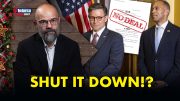
CLEVELAND — The Republican National Convention started yesterday in Cleveland, Ohio, and featured an eclectic mix of controversy and celebrity that voters have come to associate with the Trump campaign.
Despite the gamut of characters at the convention, potentially violent protesters — one of the significant concerns before the convention — are proving to be a non-issue. Security is being provided by a combination of local authorities and federal agents from the Department of Homeland Security, the Secret Service, and the Transportation Security Administration. Fears of organized protests to disrupt the event appeared overblown, as only a limited number of protesters showed up and barely were even noticeable amidst the thousands of convention attendees. The convention is taking place at the Quickens Loans Arena in downtown Cleveland, which is walking distance from the Rock and Roll Hall of Fame. Almost the entire downtown has been closed off to automobile traffic, but convention attendees are being transported to and from the convention center via a network of buses run by the committee hosting the event.
Controversy didn’t really get going until well into the first session of the day.
The first day of the convention was split into two sessions with an earlier one starting at 1:00 p.m. and ending at 5:00 p.m., before resuming for a second session at 8:00 p.m. Being focused more on procedural matters, with breakout committees finalizing the convention platform, rules, and other such details, the earlier session started almost dull, with even the speeches that were given being all very generic Republican-sounding screeds that didn’t leave any lasting impressions. That’s how it was until it came time to approve the rules for the convention.
The organized forces behind the NeverTrump movement made a last-ditch attempt to change the rules to allow delegates to “vote their conscience” and, in effect, become unbound. The idea was that the now-unbound delegates could vote for a candidate of their own personal choice, which would open the door for them to support a candidate other than Trump. Such a scenario was a long-shot strategy from the start, but if it succeeded, there was a fair chance that Trump would not have the requisite delegates needed to secure the nomination, which may have resulted in a chance for a different candidate being chosen.
The dispute reached a fevered pitch when there was a call for a voice vote to approve the rules, and it was hard to discern which response was louder. A chaotic moment of competing chants, intermixed with heavy booing, consumed the convention floor as the organizers seemed confused about how to regain control. Some in the crowd began chanting “Trump!” repeatedly to signal their support for Trump, whereas the NeverTrump supporters repeatedly chanted “roll call,” hoping to force the vote to a roll call, which had a better chance of changing the rules. Notwithstanding their best efforts, though, a motion was made to adopt the rules, and they passed on a voice vote, despite the fact that some on the convention floor argued that the yays failed to win the day.
The reactions from public figures in the NeverTrump movement were swift and heated, but for all intents and purposes, their efforts to unseat Trump as the nominee are now finally over.
The New American spoke to delegates exiting the convention shortly after the brouhaha, and there was a sense of frustration from both sides. The overall mood was that the forces that prevailed wanted to put the incident behind them, but there definitely appeared to be hard feelings that will linger. Pundits who have attached themselves to the NeverTrump movement showed no signs of backing down and continued to publicly criticize both Republican Chairman Reince Priebus and Trump. It remains to be seen if these divisions will be healed as the general election against Hillary nears or if sides have been drawn that will have an impact in Republican electoral politics for years to come.



